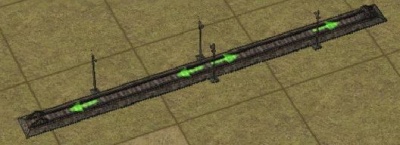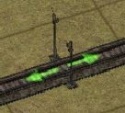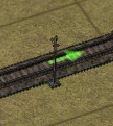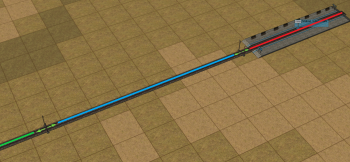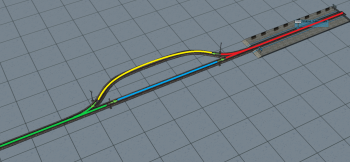Difference between revisions of "Signals"
m (block signals explanation first draft) |
m (first two examples finished) |
||
| Line 43: | Line 43: | ||
==Block signals explained== | ==Block signals explained== | ||
| − | + | Block signals allows access only on the blocks which are not occupied by other train. Block is the space of railway between two signals. You can see the block status with the arrows pointing towards the segments. Red arrow means that the block in the arrow direction is occupied.<br> | |
| − | Block signals allows access | + | |
| − | <br>''' | + | <br>'''Block signals basics'''<br> |
| − | + | [[File:Basic-segments-fin.png|350px|thumb|left|signal block on straight track]] | |
| − | + | [[File:Simple-avoidance-fin.png|350px|thumb|right|station with two track and two-way signals]] | |
| − | + | ||
| − | + | On the left picture you can see our example station situation with incorrectly positioned signals. Each block is located between two signals / end of the track and colored with different color. Red is the station block, blue is the "entry" block, green is the rest of the track.<br> | |
| + | In the real functional railroad with two trains, you will almost immediately hit the deadlock issue with the train. The problem is in the two-way signals on a single track. Very soon the trains will stay at one signal against each other. To avoid this, you can introduce some kind of avoiding track with one-way signals (right picture). You can notice that the station block is now split into two tracks with two one-way singal. One "entrance" signal, one "exit" signal. The incomming train will from the green block, to blue block. Then the train enters the station and blocks the red block. Next incomming train will have red sign on the entrance signal, because of occupied red block. The diference between left and right example is, that the train have a space to leave by the yellow block. This is effective enough on the low load railroads. | ||
| + | |||
| + | |||
[[Category:Signals]] | [[Category:Signals]] | ||
Revision as of 22:26, 19 October 2017
Game Manual
- Basics
- Game content
- Infrastructure
- Vehicles
Main purpose of signals is to prevent trains from crashing into each other while driving on the same track and that's why they are important part of any railway system - safety first guys!
Signals divide railway line into series of "blocks". If one "block" is occupied by a train then signal dividing these "blocks" won't allow any other train to enter that occupied block
until this "block" is cleared.
Placing of signals:
one left mouse button click = two way signal will be placed on a railway track
second left mouse button click on the same signal = two way signal will be transformed to one way signal
(side of the track we clicked on will determine the orientation of the one way signal)
Signals cannot be placed in tunnels, on bridges, at stations and directly on railway intersections.
Different kinds of signals:
Block signals explained
Block signals allows access only on the blocks which are not occupied by other train. Block is the space of railway between two signals. You can see the block status with the arrows pointing towards the segments. Red arrow means that the block in the arrow direction is occupied.
Block signals basics
On the left picture you can see our example station situation with incorrectly positioned signals. Each block is located between two signals / end of the track and colored with different color. Red is the station block, blue is the "entry" block, green is the rest of the track.
In the real functional railroad with two trains, you will almost immediately hit the deadlock issue with the train. The problem is in the two-way signals on a single track. Very soon the trains will stay at one signal against each other. To avoid this, you can introduce some kind of avoiding track with one-way signals (right picture). You can notice that the station block is now split into two tracks with two one-way singal. One "entrance" signal, one "exit" signal. The incomming train will from the green block, to blue block. Then the train enters the station and blocks the red block. Next incomming train will have red sign on the entrance signal, because of occupied red block. The diference between left and right example is, that the train have a space to leave by the yellow block. This is effective enough on the low load railroads.
